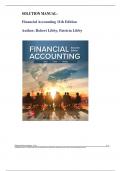SOLUTION MANUAL-
Financial Accounting 11th Edition
Author; Robert Libby, Patricia Libby
Financial Accounting, 11/e 2-1
© McGraw Hill LLC. All rights reserved. No reproduction or distribution without the prior written consent of McGraw Hill LLC.
,TABLE OF CONTENTS
CHAPTER ONE
Financial Statements and Business Decisions
CHAPTER TWO
Investing and Financing Decisions and the Accounting System
CHAPTER THREE
Operating Decisions and the Accounting System
CHAPTER FOUR
Adjustments, Financial Statements, and the Closing Process
CHAPTER FIVE
Communicating Accounting Information and Analyzing Financial Statements
CHAPTER SIX
Reporting and Interpreting Cost of Sales and Inventory
CHAPTER SEVEN
Reporting And Interpreting Cost Of Goods Sold And Inventory
CHAPTER EIGHT
Reporting And Interpreting Property, Plant, And Equipment; Intangibles; And Natural Resources
CHAPTER NINE
Reporting and Interpreting Liabilities
CHAPTER TEN
Reporting And Interpreting Bonds securities
CHAPTER ELEVEN
Reporting And Interpreting Stockholders’ Equity
CHAPTER TWELVE
Statement of Cash Flows
CHAPTER THIRTEEN
Analyzing Financial Statements
2-2 Solutions Manual
© McGraw Hill LLC. All rights reserved. No reproduction or distribution without the prior written consent of McGraw Hill LLC.
, Full Solution Manual For
Financial Accounting 11th Edition Robert Libby,
Patricia Libby, Frank Hodge
Chapter 1
Financial Statements And Business Decisions
Answers To Questions
1. Accounting Is A System That Collects And Processes (Analyzes, Measures, And
Records) Financial Information About An Organization And Reports That
Information ToDecision Makers.
2. Financial Accounting Involves Preparation Of The Four Basic Financial Statements
AndRelated Disclosures For External Decision Makers. Managerial Accounting
Involves The Preparation Of Detailed Plans, Budgets, Forecasts, And Performance
Reports For Internal Decision Makers.
3. Financial Reports Are Used By Both Internal And External Groups And Individuals.
TheInternal Groups Are Comprised Of The Various Managers Of The Entity. The
External Groups Include The Owners, Investors, Creditors, Governmental
Agencies, Other Interested Parties, And The Public At Large.
4. Investors Purchase All Or Part Of A Business And Hope To Gain By Receiving
Part Of What The Company Earns And/Or Selling Their Ownership Interest In The
Company In The Future At A Higher Price Than They Paid. Creditors Lend Money
To A Company ForA Specific Length Of Time And Hope To Gain By Charging
Interest On The Loan.
Financial Accounting, 11/e 2-3
© McGraw Hill LLC. All rights reserved. No reproduction or distribution without the prior written consent of McGraw Hill LLC.
, 5. In A Society, Each Organization Can Be Defined As A Separate Accounting Entity.
An Accounting Entity Is The Organization For Which Financial Data Are To Be
Collected. Typical Accounting Entities Are A Business, A Church, A Governmental
Unit, A University And Other Nonprofit Organizations Such As A Hospital And A
Welfare Organization. A Business Typically Is Defined And Treated As A Separate
Entity Because The Owners, Creditors, Investors, And Other Interested Parties
Need To Evaluate Its Performance And Its Potential Separately From Other Entities
And From ItsOwners.
6. Name Of Statement Alternative Title
(a) Income Statement (A) Statement Of Earnings; Statement Of
Income; Statement Of Operations
(b) Balance Sheet (B) Statement Of Financial Position
(c) Cash Flow Statement (C) Statement Of Cash Flows
7. The Heading Of Each Of The Four Required Financial Statements Should
Include TheFollowing:
(a) Name Of The Entity
(b) Name Of The Statement
(c) Date Of The Statement, Or The Period Of Time
(d) Unit Of Measure
8. (A) The Purpose Of The Income Statement Is To Present Information About The
Revenues, Expenses, And The Net Income Of An Entity For A Specified
Period OfTime.
(b) The Purpose Of The Balance Sheet Is To Report The Financial Position Of
An EntityAt A Given Date, That Is, To Report Information About The Assets,
Liabilities And Stockholders’ Equity Of The Entity As Of A Specific Date.
(c) The Purpose Of The Statement Of Cash Flows Is To Present Information
About TheFlow Of Cash Into The Entity (Sources), The Flow Of Cash Out Of
The Entity (Uses), And The Net Increase Or Decrease In Cash During The
Period.
(d) The Statement Of Stockholders’ Equity Reports The Changes In Each Of
The Company’s Stockholders’ Equity Accounts During The Accounting
Period, Including Issue And Repurchase Of Stock And The Way That Net
Income And Distribution Of Dividends Affected The Retained Earnings Of
The Company DuringThat Period.
9. The Income Statement And The Statement Of Cash Flows Are Dated ―For The
Year Ended December 31‖ Because They Report The Inflows And Outflows Of
Resources During A Period Of Time. In Contrast, The Balance Sheet Is Dated
―At December 31‖Because It Represents The Resources, Obligations, And
Stockholders’ Equity At A Specific Date.
2-4 Solutions Manual
© McGraw Hill LLC. All rights reserved. No reproduction or distribution without the prior written consent of McGraw Hill LLC.




